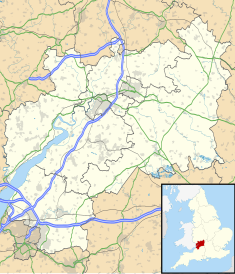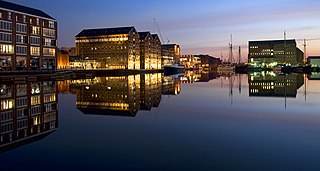
Gloucester is a cathedral city and the county town of Gloucestershire in the South West of England. Gloucester lies on the River Severn, between the Cotswolds to the east and the Forest of Dean to the west; it is sited 19 miles (31 km) east of Monmouth and 17 miles (27 km) east of the border with Wales. Gloucester has a population of around 132,000, including suburban areas. It is a port, linked via the Gloucester and Sharpness Canal to the Severn Estuary.

Guildhall is a municipal building in the Moorgate area of the City of London, England. It is off Gresham and Basinghall streets, in the wards of Bassishaw and Cheap. The current building dates from the 15th century; however documentary evidence suggests that a guildhall had existed at the site since at least the early 12th century. The building has been used as a town hall for several hundred years, and is still the ceremonial and administrative centre of the City of London and its Corporation. It should not be confused with London's City Hall, the administrative centre for Greater London. The term "Guildhall" refers both to the whole building and to its main room, which is a medieval great hall. It is a Grade I-listed building.

Sir Thomas Rich's School is a grammar school with academy status for boys and girls in Longlevens, Gloucester, England, locally known as "Tommies". It was founded in 1666 by Sir Thomas Rich.

Totnes Guildhall is a 16th-century Tudor historic guildhall, magistrate's court, and prison, in the town of Totnes, south Devon, in southwest England. It is a Grade I listed building.
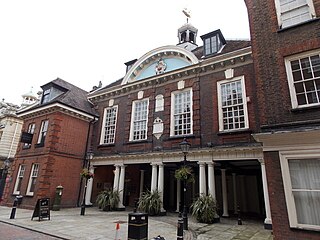
The Rochester Guildhall is an historic building located in the High Street in Rochester, Kent, England. It is a Grade I listed building.
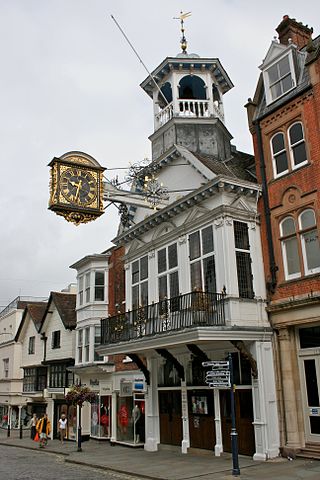
The Guildford Guildhall is a Guildhall located on the High Street of the town of Guildford, Surrey. It is a Grade I listed building.

Gloucester City Council is the local authority for Gloucester, a non-metropolitan district with city status in Gloucestershire, England.

Gloucester Shire Hall is a municipal building in Westgate Street, Gloucester. The shire hall, which is the main office and the meeting place of Gloucestershire County Council, is a grade II listed building.

The Worcester Guildhall is a municipal building in the High Street, Worcester, England. It is a Grade I listed building.

Winchester Guildhall is a municipal building in the High Street, Winchester, Hampshire. It is a Grade II listed building.
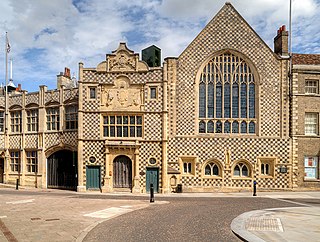
King's Lynn Guildhall, more fully referred to as the Guildhall of the Holy and Undivided Trinity, is a municipal building in Saturday Market Place in King's Lynn, Norfolk. It is a Grade I listed building. The building was substantially extended in 1895, with the whole complex now generally known as King's Lynn Town Hall, with the 1895 extension being separately listed at Grade II. It is the usual meeting place of King's Lynn and West Norfolk Borough Council.

Walsall Council House is a municipal building in Lichfield Street in Walsall, West Midlands, England. It is a Grade II listed building.

Stratford-upon-Avon Town Hall is a municipal building in Sheep Street, Stratford-upon-Avon, Warwickshire. It is a Grade II* listed building.

The Town Hall, Christchurch is a municipal building in Christchurch, Dorset, England. The building, which incorporates a room known as the mayor's parlour on the first floor, and is a Grade II listed building. It is currently the base of Christchurch Town Council.

Bridgwater Town Hall is a municipal building in the High Street, Bridgwater, Somerset, England. The town hall, which was the headquarters of Bridgwater Borough Council, is a Grade II listed building.
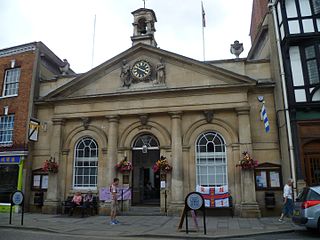
Tewkesbury Town Hall is a municipal building in the High Street in Tewkesbury, Gloucestershire, England. The building, which is the meeting place of Tewkesbury Town Council, is a Grade II* listed building.
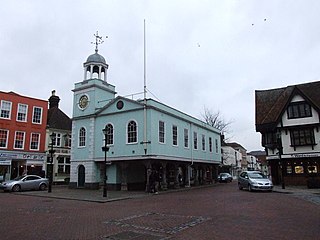
Faversham Guildhall is a municipal building in the Market Place in Faversham, Kent, England. The structure, which was the meeting place of Faversham Borough Council, is a Grade II* listed building.
Eastgate Street is one of the ancient streets in Gloucester, so named because its eastern end was originally the location of the east gate in the city's walls. The part beyond the gate as far as GL1 leisure Centre was part of Barton Street It runs from the crossroads of Northgate, Eastgate, Southgate and Westgate Streets in the West to Barton Street in the East.

Helston Guildhall, also known as Helston Town Hall, is a municipal building in Church Street, Helston, Cornwall, England. The structure, which is the meeting place of Helston Town Council, is a Grade II* listed building.

Bewdley Guildhall is a municipal building in Load Street in Bewdley, Worcestershire, England. The structure, which is the meeting place of Bewdley Town Council, is a Grade II* listed building.

